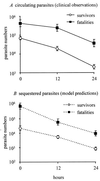Estimating sequestered parasite population dynamics in cerebral malaria
- PMID: 9636199
- PMCID: PMC22702
- DOI: 10.1073/pnas.95.13.7620
Estimating sequestered parasite population dynamics in cerebral malaria
Abstract
Clinical investigation of malaria is hampered by the lack of a method for estimating the number of parasites that are sequestered in the tissues, for it is these parasites that are thought to be crucial to the pathogenesis of life-threatening complications such as cerebral malaria. We present a method of estimating this hidden population by using clinical observations of peripheral parasitemia combined with an age-structured mathematical model of the parasite erythrocyte cycle. Applying the model to data from 217 Gambian children undergoing treatment for cerebral malaria we conclude that although artemether clears parasitemia more rapidly than quinine, the clearance of sequestered parasites is similar for the two drugs. The estimated sequestered mass was found to be a more direct predictor of fatal outcome than clinically observed parasitemia. This method allows a sequential analysis of sequestered parasite population dynamics in children suffering from cerebral malaria, and the results offer a possible explanation for why artemether provides less advantage than might have been expected over quinine in reducing mortality despite its rapid effect on circulating parasites.
Figures





References
-
- Boele van Hensbroek M, Onyiorah E, Jaffar S, Schneider G, Palmer A, Frenkel J, Enwere G, Forck S, Nusmeijer A, Bennet S, et al. N Engl J Med. 1996;335:69–75. - PubMed
-
- Tran T H, Day N P, Nguyen H P, Nguyen T H, Tran T H, Pham P L, Dinh X S, Ly V C, Ha V, Waller D, et al. N Engl J Med. 1996;335:124–126. - PubMed
-
- White N J, Ho M. Adv Parasitol. 1992;31:83–173. - PubMed
-
- Garnham P C C. Malaria Parasites and other Haemosporidia. Oxford: Blackwell Scientific; 1966.
Publication types
MeSH terms
Substances
LinkOut - more resources
Full Text Sources

